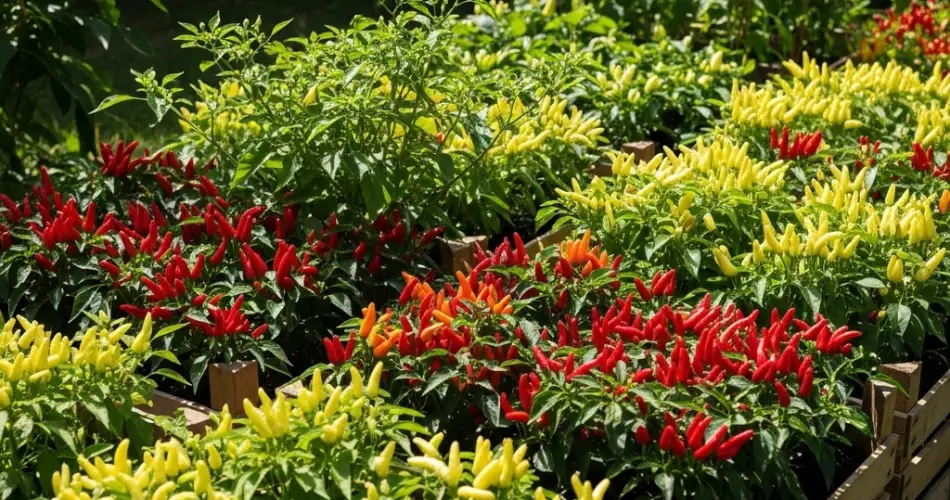Chili peppers are a favorite among home gardeners for their vibrant colors, bold flavors, and the spicy kick they bring to dishes. Even if you live in an apartment or have limited outdoor space, you can grow fiery chilies on your balcony using wooden crates. This space-saving method allows urban gardeners to cultivate a thriving chili crop with minimal fuss and maximum flavor.
Why Grow Chilies in Wooden Crates?
Wooden crates are ideal containers for balcony gardening. They provide ample depth for chili roots, ensure good drainage, and promote healthy air circulation around the soil. Compared to plastic pots, wood offers better insulation, helping to regulate soil temperature—important for heat-loving chili plants.
Crate gardening is also eco-friendly, as you can repurpose old crates, reducing waste and plastic use. Additionally, wooden crates are sturdy and easy to move, allowing you to optimize sun exposure by repositioning them throughout the day or season.
Materials You’ll Need
To get started growing chilies in wooden crates, gather the following supplies:
-
Wooden crates (at least 12 inches deep and wide enough for your chili plants)
-
Landscape fabric or burlap lining
-
Quality potting soil enriched with compost
-
Chili seedlings or seeds (choose varieties suited for container growth)
-
Organic fertilizer or compost tea
-
Stakes or small cages for plant support
-
Watering can or gentle spray hose
Selecting Chili Varieties
Not all chili peppers are created equal when it comes to container gardening. Compact or bush varieties perform best in crates and small spaces. Here are some popular options:
-
Jalapeño: Medium heat, versatile, and productive.
-
Thai chili: Small, fiery peppers that grow well in containers.
-
Cayenne: Long, slender peppers with moderate to high heat.
-
Habanero: Extremely hot peppers, best grown with extra care.
-
Bell peppers: Sweet, mild peppers that add color and variety.
Choosing a variety that matches your spice preference and container size ensures a successful harvest.
Preparing the Wooden Crate
Line your wooden crate with landscape fabric or burlap to keep soil contained while allowing water drainage. If the crate lacks drainage holes, drill several small holes at the bottom to prevent water accumulation, which can lead to root rot.
Fill the crate with a well-draining potting mix rich in organic matter. Chilies thrive in fertile soil that retains moisture but drains well. Avoid heavy garden soil that can compact and suffocate roots.
Planting Your Chilies
If starting from seeds, sow them indoors 8–10 weeks before the last expected frost date. Once seedlings have at least two sets of true leaves and outdoor temperatures stay consistently warm (above 60°F or 15°C), transplant them into your crate.
When transplanting, space plants about 8–12 inches apart to give them room to grow. Dig holes just large enough to accommodate the root balls, place seedlings carefully, and backfill with soil. Firm the soil gently around the base and water thoroughly.
Positioning and Sunlight
Chili peppers need plenty of sunlight—ideally 6 to 8 hours of direct sun daily. Place your crate in the sunniest part of your balcony. If space or light is limited, consider rotating the crate periodically to ensure even growth.
Balconies with afternoon shade can still work well, but peppers grown in full sun tend to produce more and hotter fruit.
Watering and Feeding
Keep the soil consistently moist but avoid waterlogging. Water when the top inch of soil feels dry. In hot weather, peppers may need daily watering to prevent stress.
Feed your plants every two weeks with a balanced organic fertilizer or compost tea. Once fruit sets, switch to a fertilizer higher in potassium to promote better fruit development.
Supporting Your Plants
Some chili varieties can grow tall and heavy with fruit, so support may be necessary. Use small stakes or cages to keep plants upright and prevent branches from breaking under the weight of peppers.
Tie plants loosely with soft garden twine to avoid damaging stems.
Managing Pests and Diseases
Common pests include aphids, spider mites, and whiteflies. Inspect your plants regularly and use organic pest control methods such as neem oil or insecticidal soap when needed.
To prevent fungal diseases like powdery mildew or root rot, avoid overhead watering and ensure your crate has good drainage and airflow.
Harvesting Your Chilies
Chilies can be harvested when they reach full size and color, which varies by variety. Some peppers are best picked green, while others develop sweeter or hotter flavors as they mature to red, orange, or yellow.
Use scissors or pruning shears to snip peppers from the plant to avoid damaging stems. Regular harvesting encourages continuous fruit production.
End-of-Season Care
After the growing season, remove old plants and debris to prevent disease. Compost healthy plant material and refresh the soil in your crate with fresh compost for your next crop.
Rotating crops or growing herbs in the crate the following season helps maintain soil health.
Final Thoughts
Growing chili peppers in wooden crates is an accessible and rewarding way to bring heat to your balcony garden. With the right setup, sunlight, and care, you’ll enjoy a bountiful harvest of fresh, flavorful chilies all season long. Whether you prefer mild sweet peppers or fiery hot varieties, crate gardening makes it possible to grow your favorites in small urban spaces.



